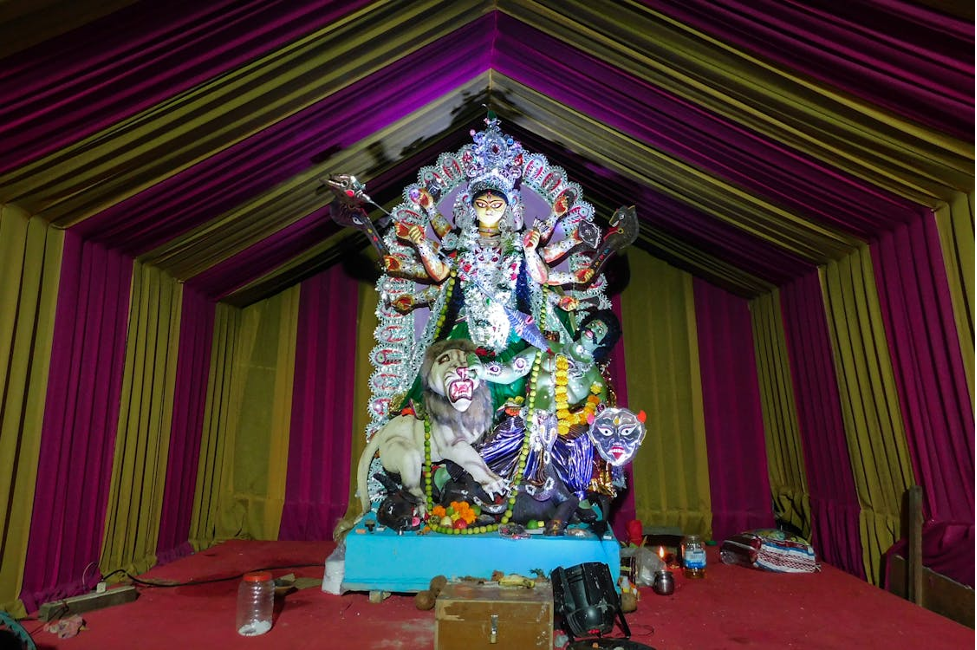Traditional Pooja Decoration Ideas to Enhance Your Spiritual Space
Pooja, or worship, is an integral part of spiritual and religious practices in many cultures, especially in Hinduism. It involves offering prayers, flowers, incense, light, and other items to deities, seeking blessings for prosperity, health, and happiness. To make the pooja experience more meaningful, the space where the ritual takes place should be decorated with elements that enhance its spiritual aura. Traditional pooja decorations not only elevate the atmosphere but also help in creating a sacred and tranquil environment that allows for deep devotion.
In this article, we will explore traditional pooja decoration ideas that can transform any space into a divine sanctuary for your prayers and worship.
1. The Importance of Pooja Decoration
Before delving into decoration ideas, it’s essential to understand why decorating the pooja space is so significant. In many spiritual practices, the space where pooja is conducted is considered sacred. The environment plays an essential role in creating the right atmosphere for prayer, meditation, and connection with the divine.
Pooja decorations are believed to invite positive energy into the home and help maintain a sense of peace and tranquility. Each element used in the decoration, such as flowers, lights, and incense, holds symbolic importance and contributes to the overall sanctity of the ritual.
2. Choosing the Right Space for Pooja
The first step in creating an ideal pooja area is choosing the right space in your home. Ideally, the pooja room should be in the northeast corner of the house, as this direction is considered auspicious and conducive to spiritual energy. However, if this is not feasible, a clean and quiet corner of the house, preferably away from distractions, can also serve as an appropriate space for pooja.
The pooja area should be kept clutter-free, tidy, and well-lit. The floor should be cleaned before the pooja, and a designated altar or platform should be set up to place the deity’s idols or pictures.
3. Floral Decorations for Pooja
Flowers play an integral role in Hindu pooja ceremonies, symbolizing purity, beauty, and devotion. They are used extensively for both decoration and offerings to the deities. The most popular flowers used in pooja decorations include marigolds, jasmine, roses, lotuses, and chrysanthemums. These flowers are not only visually appealing but also carry religious significance.
How to Use Flowers in Decoration:
- Garlands: Create beautiful garlands using marigold flowers to drape around the deity’s idol or picture. These garlands can also be used to decorate the entrance to the pooja room or hang above the pooja altar.
- Petals: Spread fresh flower petals in front of the deity or around the altar as a symbol of reverence. You can also use petals to create a decorative pattern on the floor, resembling a rangoli or mandala.
- Pooja Thali: Decorate your pooja thali (plate) with flowers. A few petals placed on the thali not only enhance its beauty but also add a touch of fragrance to the pooja ritual.
4. The Use of Diyas and Lamps
Lights are a crucial element in traditional pooja decorations, symbolizing the removal of darkness and the arrival of light and wisdom. Diyas (small oil lamps) are typically lit during pooja as a symbol of offering light to the deities. They create a warm, inviting glow and are essential for setting the right spiritual mood during worship.
Decorating with Diyas:
- Around the altar: Place small clay diyas in a circle around the pooja altar or around the idol of the deity. This gives the entire setup a peaceful and glowing look.
- Rangoli Designs: Create a traditional rangoli design on the floor using diyas in the center of the pattern. The light from the diyas enhances the beauty of the rangoli and adds an ethereal touch to the space.
- Hanging Diyas: You can also hang decorative diyas or oil lamps from the ceiling to create an enchanting atmosphere. These can be placed in ornamental metal or glass holders.
5. Incorporating Incense Sticks and Agarbattis
The fragrance of incense is closely associated with pooja rituals, and burning incense sticks or agarbattis during pooja is a common tradition. The aromatic smoke rising from the incense symbolizes the offering of prayers and devotion to the deities. Additionally, the sweet fragrance fills the pooja room, creating a serene and calming atmosphere.
How to Use Incense in Pooja Decorations:
- Incense Holder: Place an incense holder with burning incense near the pooja altar. You can use traditional wooden or brass incense holders, or decorative ceramic pieces.
- Aromatherapy: If you prefer, you can burn scented candles in addition to incense sticks for a layered fragrance that enhances the ambiance.
- Agarbatti Stands: You can also use multi-tiered agarbatti stands to hold multiple incense sticks at once, creating a beautiful visual effect along with a fragrant atmosphere.
6. Decorating with Torans and Bandhanwars
Torans and bandhanwars are decorative items that are commonly used to adorn the entrance of the pooja room or the doors of the house during festivals and special occasions. These decorations are typically made with mango leaves, marigold flowers, or other sacred elements.
- Torans: A toran is a decorative garland made of flowers, leaves, or beads that is hung over doorways or windows. It is believed to bring positive energy into the home. You can create a beautiful toran by stringing together marigolds and mango leaves or even using bright colored ribbons.
- Bandhanwar: Similar to a toran, a bandhanwar is often made using flowers, leaves, and beads, but it can also include pieces of fabric or other decorative elements. These are usually hung at the entrance to welcome guests or as part of the pooja setup.
7. Using Traditional Pooja Thali (Plate)
A well-decorated pooja thali is essential to a traditional pooja. The pooja thali is where all the items used in the ritual are placed, including the flowers, fruits, incense, oil lamp, and offerings. A beautifully decorated thali can add a touch of elegance to the pooja ceremony.
How to Decorate a Pooja Thali:
- Silver or Brass Thali: Invest in a traditional silver or brass thali to add a sense of grandeur to the pooja. These materials are considered auspicious and are often used in rituals.
- Add Elements: Decorate the thali with flowers, small diyas, fresh fruits, and sweets. You can also place a small bell and conch on the thali to enhance the spiritual aspect of the ritual.
- Use Colored Cloth: Lay a colorful cloth or silk piece as a base on the thali. This can be an elegant way to tie together your decorative elements.
8. Traditional Textiles for Pooja
Textiles such as silk, cotton, or wool can be used creatively to decorate the pooja room or altar. You can lay down a decorative cloth or rug under the pooja altar to create a more regal look. For the pooja itself, a small cloth or piece of silk can be used to cover the deity’s idol or picture, adding a sense of reverence.
Textile Decoration Ideas:
- Pooja Mat or Carpet: Lay down a small pooja mat or a decorative carpet to sit on during the pooja. This not only enhances comfort but also adds to the sacredness of the occasion.
- Ritual Cloths: Use ritualistic textiles such as a white or yellow cloth to cover the pooja thali or the deity’s statue.
9. Incorporating Spiritual Symbols
Adding spiritual symbols like swastikas, Om symbols, and other sacred icons can further enhance the pooja decorations. These symbols carry deep spiritual meaning and are considered auspicious in Hindu rituals.
- Om Symbol: You can place an Om symbol in the center of your pooja room or decorate the walls with it.
- Swastika: This symbol of prosperity and good fortune can be drawn with red vermilion powder or created using flowers around the pooja area.
10. Cultural and Regional Variations in Pooja Decorations
The way pooja is decorated can vary greatly depending on regional customs, cultural practices, and specific rituals. For example, in South India, banana leaves may be used to decorate the pooja area, while in North India, clay lamps and brass utensils are commonly used.
It’s essential to consider your cultural background when decorating your pooja space, as this will ensure that the decorations align with your traditions and rituals.
Conclusion
Traditional pooja decoration ideas play a pivotal role in creating a sacred space that fosters devotion and spiritual well-being. By incorporating elements like flowers, diyas, incense, and spiritual symbols, you can transform your pooja area into a divine sanctuary. These decorations not only enhance the beauty of the pooja but also help create an environment that fosters a deep connection with the divine.
Whether you are preparing for a special occasion, festival, or daily pooja, these ideas will help elevate your pooja experience and bring positive energy into your home.




